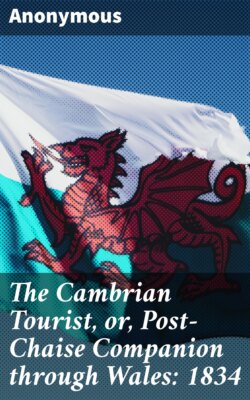Читать книгу The Cambrian Tourist, or, Post-Chaise Companion through Wales: 1834 - Anonymous - Страница 9
На сайте Литреса книга снята с продажи.
KINGSWESTON,
ОглавлениеTable of Contents
the seat of Lord de Clifford, is about four miles north-west of Bristol. It is a noble mansion, built by Sir John Vanbrugh, somewhat in his usual style; but the situation according with the style better than usually fell to the lot of that architect, it has a grand and noble effect. The collection of paintings here are by esteemed masters, and very fine; the gardens, hot-houses, &c. are kept up in very great style. The park, which is richly wooded and beautifully diversified, offers a rich treat to the painter; the varied prospects obtained at every turn and opening of its numerous walks and vistas are as rich and extensive as nature in this climate can afford. The whole, under very trifling restrictions, are most kindly and liberally left open by his Lordship, for the public to enjoy. Kingsweston inn, just above the park, is a comfortable house, delightfully situated.
To the west of Kingsweston, on a hill called Penpold, is a pleasure-house: from this hill, which is of great height, the most beautiful prospects are to be enjoyed. You look down on that fine sheet of water, Kingroad and the Severn Sea; commanding alternately views of Somersetshire, Glamorganshire, and Monmouthshire, with Wales in the back ground; Gloucestershire and Wiltshire: this with the bustle of the shipping in the nearer sea view, so engage the attention, that time flies unheeded by.
From hence proceed to Shirehampton, a pleasing village, leading to a good inn, called Lamplighters’ hall, a place of considerable resort, during the summer months, to witness the busy scene at the mouth of the Avon: it is situated close to high water-mark, on the bank of the river, opposite to Pill or Crockern Pill, where is a Custom-house, at which all vessels leaving the port of Bristol are obliged to take their last clearance in going out, and from which they are furnished with pilots inwards. The ride from hence, when the tides are not too high, over turf to the mouth of the Avon, is very fine. The house is built purposely to enjoy the busy scene which the river and Kingroad here present; and its accommodations are remarkably good, and the charges reasonable.
Frenchhay, in Gloucestershire, is about four miles north-east of Bristol; the drive this way is beautiful, from the numerous noblemen and gentlemens’ seats and highly cultivated grounds, which occupy both sides of the road. It was here, during the war, that the great depôt of French prisoners was established.
At the east end of the common is a remarkable lusus naturæ, which was taken out of a stone quarry at Downend; its form is an entire perfect muscle, consisting of the upper and under shell, which are closed together; its weight is nearly two tons.
Bristol is but one stage from either the Old or New Passage; it is eleven miles to the New, and nine to the Old. The mail and most of the coaches pass their passengers, &c. by the New Passage, as saving a stage on the Milford road. Chaises or horses are generally charged at the rate of twelve miles to either.
At Aust (or the Old Passage) it is about two miles over to Beachley, in the parish of Tidenham, Gloucestershire. This is the direct way to Chepstow, Newent, and all the forest of Dean, Herefordshire, Worcestershire, and the upper part of Monmouthshire.
At the New Passage, it is about three miles over at high water to Port Skewith, near St. Pierre in Monmouthshire. When the wind is S.E. or N.W., it is directly across the river, therefore you must be at the passage where you intend to cross, an hour before high water, as they can only go over then, and that but once, there being no passage during the flood or ebb.
Should the traveller have before visited Bristol, or decline this excursion, he will find the walk from Gloucester to
